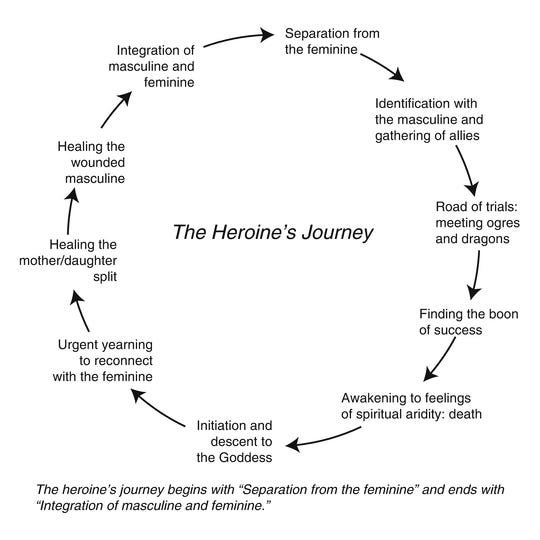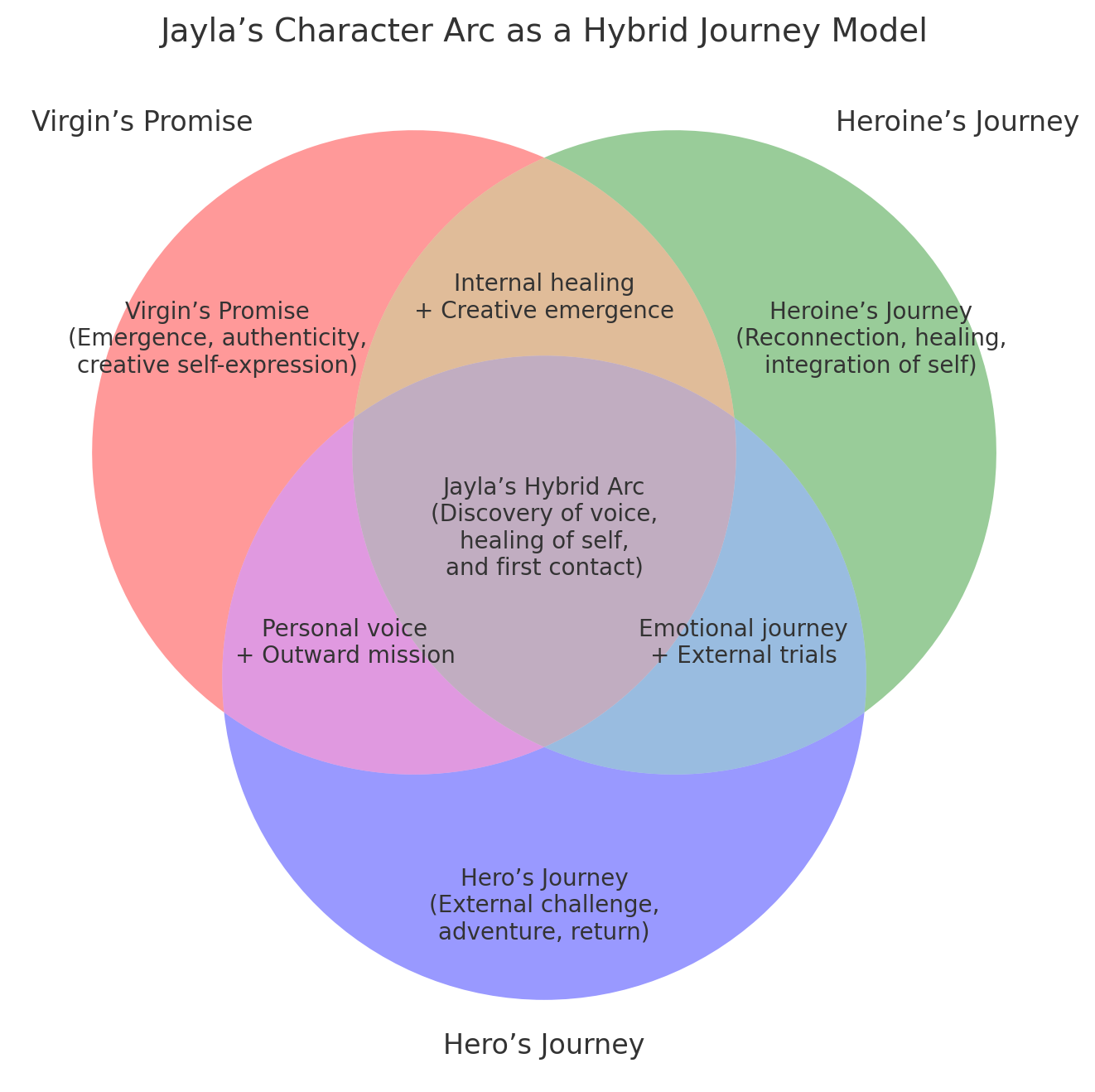The Story Beneath the Structure
Mapping a Heroine’s Hybrid Arc
Before we begin weaving journeys, let’s acknowledge something too often unspoken.
“[Do not be] silent about deeper issues important to women: the archetypal, the intuitive, the sexual, and the cyclical, the ages of women, a woman’s way, a woman’s knowing, her creative fire.”
Clarissa Pinkola Estés, (Adapted from Women Who Run with the Wolves)
Stories begin long before the first word is written. In World Beyond the Song, my protagonist Jayla exists more as breath and echo than ink and page—but her arc is already alive. As I prepare to write her journey, I find myself drawing not from a single narrative mold, but from a tapestry of transformational frameworks.
While this essay is not an analysis of a finished character arc, it is a living blueprint. A writer’s reflection on how models like the Hero’s Journey, the Heroine’s Journey, and the Virgin’s Promise can inform, inspire, and illuminate a path for character development that honors complexity, contradiction, and inner truth.
If you are a storyteller who senses that your character’s becoming doesn’t fit in a single box, this essay is for you.
First, however, it’s important to define some terms.
Character arc, story arc, story structure, and journey structure are often used interchangeably in craft literature; however, within this discussion, I suggest they have very specific meanings.
Character arc—how a character grows emotionally, or transforms internally over the course of a story.
Story arc—the plot and its narrative shape; the tension, events, and stakes from beginning to end.
Story structure—a framework for organizing the narrative content—scene to scene, or act to act. Think: Three- or Four-Act structure, the Hero’s Journey, or Beat Sheets.
Journey structure—a specialized type of story structure that uses archetypal milestones of a transformative journey, especially spiritual, mythic, or psychological. Again, think: Joseph Campbell and Christopher Vogel’s Hero’s Journey, Maureen Murdock’s Heroine’s Journey, or Kim Hudson’s Virgin’s Promise.
While story arc and structure shape the events and rhythm of the plot, this essay centers on the emotional architecture—the character arc—as it unfolds within and alongside those external frames. In World Beyond the Song, Jayla’s internal journey doesn’t follow a single model. Instead, it draws from several interwoven narrative lineages that, when combined, reflect her struggle to reclaim agency, connection, and voice.
I’m a plotter. Structure is my creative scaffolding. I thought I had settled on the framework for World Beyond the Song, but something still felt off. Jayla didn’t belong to just one path—and I began to suspect I needed to break, reassemble, and reshape the mold.
I would crack and piece together four models—Story Grid, Four-Act Structure, Hero’s Journey, and Murdock’s Heroine’s Journey to assemble what now seemed to fit—a hybrid story structure.
Please note there is another model of the Heroine’s Journey by Gail Carriger. This version offers immense value for many story types—particularly those emphasizing community, charm, and romantic alliance—but for Jayla’s solitary emergence and deep psychological wound, it didn’t provide the scaffolding I needed.
And structure is just an underpinning. Jayla would be secure in this hybrid state so long as she had the proper character arc. Again, this couldn’t be, nor shouldn’t be (for me) straightforward or simple. Jayla is neither, and while I appreciate the hero, Jayla’s story was not about destiny; she was not a hero, nor did I want her to be. She is on a quest, to be sure, but that quest is an internal one—one of emergence.
That’s when I met the Maureen Murdock’s Heroine’s Journey. Taking what fit from Hero’s Journey and melding it with this Heroine’s Journey felt near perfect.
I hadn’t expected to find perfection. But just when I thought I had everything in place, someone dropped the Virgin’s Promise in my lap.
Jayla’s character arc is now shaped by these three frameworks, and reflects a layered, hybrid transformation—both internal and external.
Before lining up these models in more detail, it might benefit to give you a brief synopsis of World Beyond the Song. Even though its full course has yet been charted, I know enough of its intention relevant to character arcs, and therefore, this essay.
World Beyond the Song follows xenolinguist Jayla Finn as she searches for alien life—and something far more elusive: belonging. After suffering a profound personal loss, Jayla returns to her lab on the new world of Talamh Ru, where she’s partnered with an AI parrot named o2, who may be more than mere code. When a mysterious signal interrupts their work, Jayla must navigate scientific protocol, institutional pressure, political manipulation, and her own long-silenced grief as she is drawn into a journey that mirrors transformation in the form of descent and return—not a quest for power, but for integration. The deeper she listens, the more she must reconcile her pragmatic mind with the emotional echoes she has long suppressed. Connection—across species, stars, and self—may be the final language she learns to speak.
When I first began charting Jayla’s emotional path, I found myself drawn to the Hero's Journey. It was accessible … and it matched what I was imagining for the outward-facing stakes of first contact, mission, and challenge.
The Hero’s Journey—The Call, the Quest, and the Return
Naturally, I began with the familiar. The Hero’s Journey—with its call, its descent, its triumphant return—has long guided storytellers. And in many ways, it offered me a shape. But the deeper I listened to Jayla, the more I realized: she wasn’t trying to win. She was trying to remember who she had once been.
Many stages of the Hero’s Journey are relevant to the challenges and transformation of the protagonist in a first contact story. In particular: Call to Adventure, Meeting the Mentor, Crossing the Threshold, Tests, Allies, and Enemies, and The Ordeal. Additionally, the Reward and Return stages reflect possible outcomes of a first contact mission.
For the character—rather than the action driven story that is World Beyond the Song— however, the Call to Adventure, the Quest, which in this case is actually ‘transformation’, and Return are quite relevant to Jayla’s character arc.
Transformation requires a trigger, a catalyst. This catalyst is the call to adventure, and for Jayla, that call was a mysterious signal in the universe.
This signal doesn’t just launch external investigation into an event she has long dreamed of. It forces her to question what she has come to rely on—both scientific and political paradigms—questions that mirror a profound personal struggle.
Answering this call unwittingly opens her to change; refusing it leaves no story, no quest. The Return, the final stage, answers the Call.
Will Jayla integrate her journey's knowledge and experience, returning to her ordinary world, yet seeing it anew? These points along her growth curve, her character arc, are relevant, but some points are absent to enable authentic transformation.
I came to understand the call to adventure was only one layer. Jayla’s inner wounds demanded a different map: a deep descent.
The Heroine’s Journey—Disconnection, Descent, and Integration
I found resonance with Murdock’s Heroine’s Journey as a conduit to honor the emotional spine of Jayla’s arc. Contrary to what some may superficially consider, the Heroine’s Journey is not simply the Hero’s Journey with a gender swap.
Murdock declares, “Women’s lives have a mythology different than men’s.” As a creative writing instructor, although she taught it, she found Campbell’s Hero’s Journey “lacking in spirituality” and virtually ignoring the “deep wounding of the feminine on a personal or cultural level.”
Of course, this resonated with me! All manner of bells sounded with recognition. Jayla is deeply wounded; she needed a narrative arc that allowed but honored her descent into recovery.
Jayla isolates herself from colleagues and even shuts out o2, reflecting her separation from both feminine and relational aspects. If she could not connect with herself, how would she ever connect with … whatever else was out there?
Heroine’s journeys are necessarily about descent—spiritually. It’s important to understand that descent is a fall of sorts, a downward movement, yes.
But more than falling—it's falling inward, into the self, where healing, emotional growth, and emergence or transformation begin.
I found this to be a hugely vital element missing from my solo dependence on the Hero’s version of journey.
Murdock describes ten stages leading to restoration or growth—including separation from the feminine, identification with the masculine, road of trial, illusory boon of success and reconnecting with the feminine. Jayla had lost all sense of connection and will have to descend into grief, isolation and doubt to find her way. To not only make first contact with an alien species, but to belong in her own world.
Jayla’s arc felt well-shaped at this point, and I was feeling pretty settled with it … until I encountered a third model that revealed an even deeper undercurrent—Kim Hudson’s Virgin’s Promise.
The Virgin’s Promise—Emergence from the Hidden Self
Jayla's journey, as I've hopefully shown, defies easy categorization. Like many fictional women, she navigates not just loss and healing (the heroine's path), or challenge and return (the hero's journey), but also the deeply personal quest of self-discovery, or re-discovery. This intimate arc is what Kim Hudson so skillfully charts in The Virgin's Promise.
Unlike Hero's Journey, Virgin's Promise distinguishes myths from fairy tales. Hudson argues that myths emphasize self-sacrifice, contrasting with fairy tales' focus on self-fulfillment. And this isn't simply a gendered distinction. Hudson acknowledges both masculine and feminine elements in each.
Mythical archetypes highlight duty-driven quests demanding physical independence, culminating in overcoming fear through self-sacrifice. Fairy tales, conversely, prioritize inner transformation, emphasizing self-worth, self-discovery, psychological independence, and ultimately, self-fulfillment.
Beyond the distinction between myths and fairy tales, the 13 stages of Virgin’s Promise somewhat parallels the 12 stages of Hero’s Journey, winding through dependent world, price of conformity, dresses the part, secret world, caught shining, wanders in the wilderness, re-ordering/rescue, and more.
Without revealing too much, Jayla builds a secret world, but a pivotal moment—a "caught shining phase"—forces a collision with her everyday life.
When she recognizes a familiarity to the alien signal, Jayla is forced to revisit a deep grief at having abandoned a childhood promise—something she felt compelled to do in order to belong.
But she will never truly be connected to anyone, anything, until she confronts her shadow self, ultimately revealing her true worth, both to herself and others.
While the Heroine’s Journey explores recovery from inner fracture, the Virgin’s Promise offers something more intimate: a map for emerging from suppression. It charts the story of a character who lives under expectations—whether familial, cultural, or internalized—and slowly dares to bring their hidden truth into the light.
Unlike the hero, who often sacrifices self for the world, or the heroine, who seeks reintegration, the virgin moves toward self-fulfillment. Her journey is not about saving others or mending old wounds—it’s about stepping into her own light, even when the world resists it.
The virgin’s arc unfolds quietly at first: in private acts of rebellion, secret creations, and unseen growth, until a turning point—a moment when she is “caught shining”—requires her to choose between retreat and full expression.
This is the heart of the Virgin’s Promise: the quiet becoming that precedes a luminous truth. It’s not the call to adventure, but the whisper to emerge.
Once I recognized this shape beneath Jayla’s surface, I saw it not only in her—but in characters like Rocky, whose journeys revolve not around conquest, but the courage to be fully seen. When has losing a fight ever meant so much?
As the creator of this world and its characters, the layering is essential, and it is essentially authentic. And while not all stories or characters require such depth or layering, I believe Jayla and World Beyond the Song do.
Jayla’s Hybrid Arc—Character of Many Journeys
Jayla’s character arc, shaped by these three frameworks, reflects a layered, hybrid transformation—both internal and external.
Hero’s Journey providing solid pacing for external stakes, such as exploration, risk, and confrontation;
Heroine’s Journey addressing the emotional disconnection, and loss the protagonist must undergo; and
Virgin’s Promise which deeply reflects her creative emergence, internal conflict, and quiet defiance.
Why This Matters for Writers
Readers are drawn to speculative fiction for a variety of reasons—to escape, to explore complex themes, and to greet an opportunity to develop empathy and understanding. I write for these very reasons while also hoping to foster critical thinking and addressing societal issues—all on a what-if inspired canvas.
I doubt, in reality, such a canvas would hold a single palette, nor would I expect it to. Jayla’s transformation needs to be authentic, and therefore is colored by several palettes spread across an unfixed canvas.
I imagine many writers feel their artistry in such a way. Character arcs pulling from a multitude of models lays the foundation for layered and meaningful interpretation.
Yet complexity is not required in every form of fiction. Authenticity and the willingness to suspend belief or fantasize, however, are required—if an author wants to be read.
Nonetheless, multimodal arcs are something I would encourage every writer to explore. I do not buy into the idea that one model fits all, but I willingly invest in mix-and-match, especially if my character is demanding more of me.
Who knows if these are the final contributions to portraying Jayla’s arc? The good news is, even though I plot, I gladly bend to whims of the story and its characters, and some of these things, I believe, are things we cannot know ahead of time—not if we are allowing our characters to be authentic.
But I feel settled, again, with the melding of these three models.
Conclusion
The power of ‘three’ is a well-known phenomenon. It feels right. Here and now.
In walking the threads between structure and soul, Jayla teaches us that becoming is not linear, not singular, but luminous in its intersections.
So what about you? Have you broken the bonds of a single scope? It’s certainly not necessary, but I would be delighted to know.
Single model or conglomerate of many—where do you find your narrative arc? Do you know it ahead of time? Do your characters demand you follow their lead?
If you’ve spent time studying or writing about journey structures—particularly the Heroine’s or Virgin’s arc—I’d love to hear your thoughts. What threads do you see emerging? What models have guided your own stories?
I have so many questions, and so few (if any) answers. I would love to know how you answer the call of your writing journey, and if you have a female protagonist, is her journey one of action quest or descent into inner transformation?
Do let me know.
Suggested Reading—Expanding the Arc
Maureen Murdock
Book: The Heroine’s Journey: Woman’s Quest for Wholeness
Approach: Murdock offers a counter-journey to Campbell’s model—centered on healing the split between the feminine and the masculine within. Her ten-stage journey explores emotional exile, spiritual descent, grief, and eventual integration, especially for women or characters wounded by patriarchal expectation or internal disconnection.
Kim Hudson
Book: The Virgin's Promise: Writing Stories of Feminine Creative, Spiritual and Sexual Awakening
Approach: This is a direct counterpoint to Campbell. Hudson’s Virgin’s Promise outlines a 13-beat story structure for characters (not necessarily women) who grow by claiming inner truth, often from a place of suppression to radiant authenticity—more about being than doing.
Joseph Campbell
Book: The Hero with a Thousand Faces
Approach: Campbell identifies the monomyth or “Hero’s Journey,” a universal pattern across world myths centered on the call to adventure, trials, and return. His structure is outward-facing, focusing on individualism, sacrifice, and transformation through confrontation. It remains foundational for epic and externally motivated narratives.
Christopher Vogler
Book: The Writer’s Journey
Approach: Vogler adapts Campbell’s Hero’s Journey for modern storytelling, especially screenwriting. His model emphasizes archetypes (mentor, shapeshifter, shadow) and a streamlined 12-stage story structure. Accessible and pragmatic, it's widely used in genre fiction and film.
Gail Carriger
Book: The Heroine’s Journey
Approach: Carriger reframes the journey as one of relational restoration and emotional balance. Her heroine thrives through community, connection, and return to support systems rather than isolation or conquest. It's particularly applicable to commercial fiction, romance, cozy fantasy, and ensemble narratives.
Denise J. Ross
Book: The Heroine’s Journey for Filmmakers
Approach: Ross translates the Heroine’s Journey into a practical screenwriting guide. She critiques Campbell's dominance in film and offers alternative beats rooted in emotional vulnerability, community, and psychological rebirth—especially valuable for writing female protagonists with layered inner worlds.
Valerie Estelle Frankel
Book: From Girl to Goddess: The Heroine's Journey through Myth and Legend
Approach: Frankel presents a 13-stage Heroine’s Journey, analyzing hundreds of myths and modern stories (e.g., Buffy, The Hunger Games) to argue that heroines follow a pattern distinct from Campbell’s model—often involving collaboration, transformation through love, or reintegration of the self rather than solo conquest.
Christine Downing
Work: The Goddess: Mythological Images of the Feminine
Approach: Downing explores how feminine myths (Persephone, Demeter, Inanna) offer journeys of descent, death, and return that differ significantly from masculine conquest arcs. Her psycho-spiritual approach emphasizes depth psychology, myth, and archetypal narrative as tools for feminine transformation.
Clarissa Pinkola Estés
Book: Women Who Run With the Wolves
Approach: Not a direct structural model like Campbell’s, but Estés offers powerful narrative archetypes rooted in the wild woman/intuition psyche. These involve themes of descent, reclamation, and individuation through stories like Bluebeard and La Loba.
Jean Shinoda Bolen
Books: Goddesses in Everywoman, Crossing to Avalon, The Heroine’s Journey
Approach: Bolen, a Jungian analyst, maps journeys of psychological integration and spiritual awakening in feminine terms—often drawing on Greek goddess archetypes and personal memoir. Her work bridges myth, psychology, and identity, offering personalized paths toward wholeness.
Carol S. Pearson
Books: The Hero Within, Awakening the Heroes Within
Approach: Pearson introduces a set of twelve universal archetypes for transformation and personal development, including many that resonate with traditionally “feminine” journeys (e.g., caregiver, lover, everyperson). Her focus is more psychological and gender-neutral, but her reframing opens space for inclusive journeys.







I'm definitely a fan of mixing models. I tend to start with a very vague idea and some characters, so I'll use something like the 7-point structure to get the outline of a story. Then I'll flesh it out with story circle, save the cat, etc., adding meat to the bones, so to speak, with each iteration.
My current project has a female protagonist, and she is definitely on a journey of emergence in the face of external expectations. So I appreciate you bringing Virgin's Promise to my attention! Definitely something I'll be learning more about in the near future.
I like the concept of "falling inward."